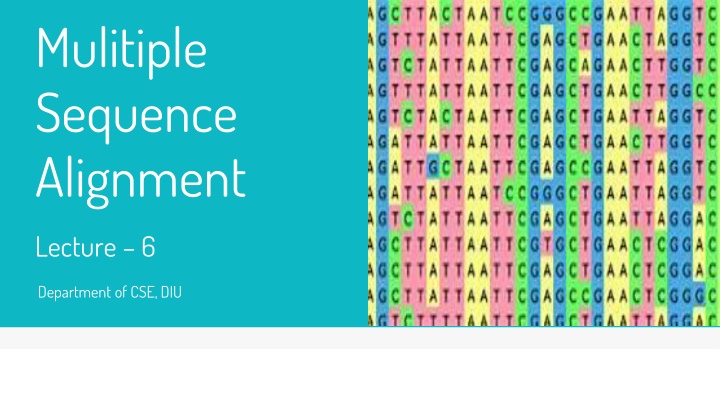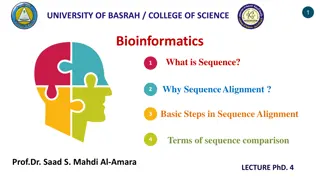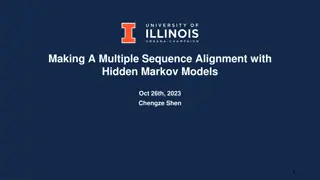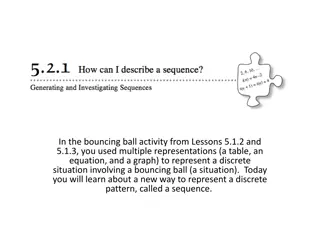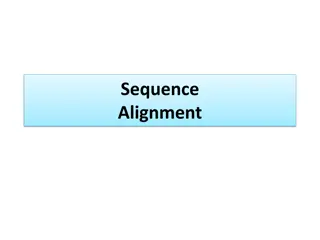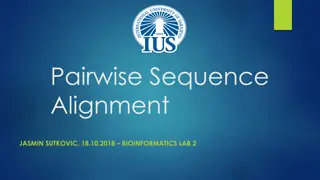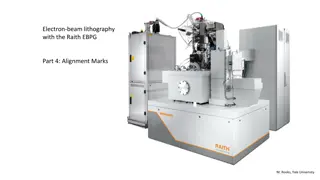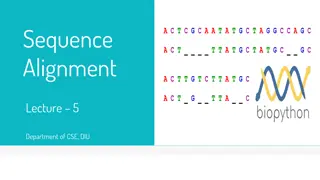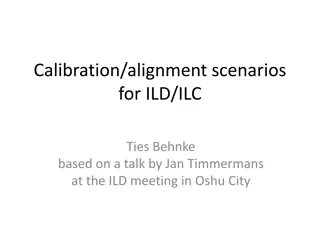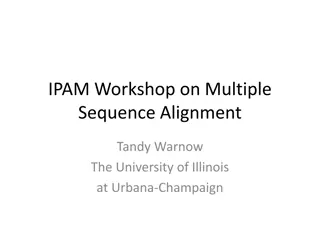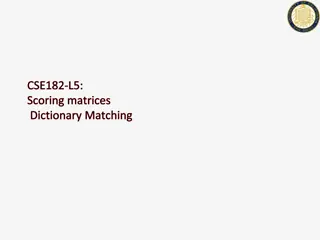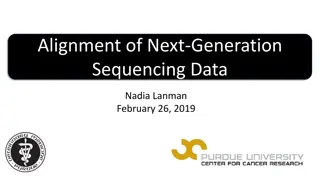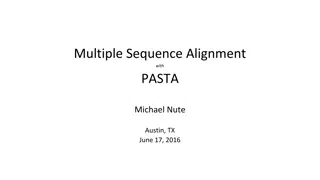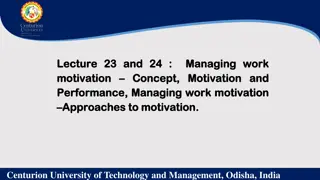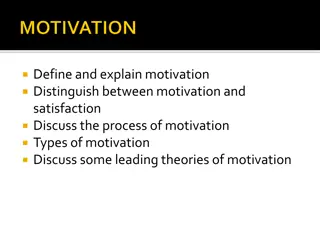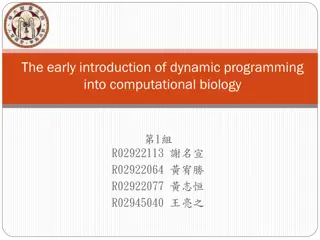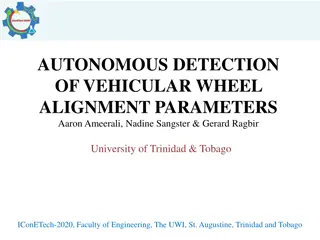Multiple Sequence Alignment Methods and Motivation
Multiple Sequence Alignment (MSA) involves aligning three or more biological sequences to reveal evolutionary relationships and subtle similarities. Various methods like Dynamic, Greedy, Progressive, and Iterative approaches are used to overcome challenges in MSA. The motivation behind MSA includes finding similar functional parts in genes, predicting protein structures, genome assembly, and phylogenetic analysis initiation. MSA is crucial for identifying weakly conserved regions and automating genomic fragment reconstruction.
Download Presentation

Please find below an Image/Link to download the presentation.
The content on the website is provided AS IS for your information and personal use only. It may not be sold, licensed, or shared on other websites without obtaining consent from the author.If you encounter any issues during the download, it is possible that the publisher has removed the file from their server.
You are allowed to download the files provided on this website for personal or commercial use, subject to the condition that they are used lawfully. All files are the property of their respective owners.
The content on the website is provided AS IS for your information and personal use only. It may not be sold, licensed, or shared on other websites without obtaining consent from the author.
E N D
Presentation Transcript
Mulitiple Sequence Alignment Lecture 6 Department of CSE, DIU
CONTENTS 1. Multiple Sequence Alignment (MSA) -Why Multiple Sequence Alignment -Multiple Sequence Alignment: Motivation -MSA Challenges 2. Multiple Sequence Alignment Methods -Dynamic Method: Impractical -Greedy Method -Progressive Method -Iterative Method
1. Multiple Sequence Alignment (MSA) Why Multiple sequence, Motivation, Challanges
Multiple Sequence Alignment V T I S C T G S S S N I G V T LT C T G S S S N I G V T LS C S S S G F I F S V T LT C T V S G T S F D V T I T C V V S D V S H E V T LV C L I S D F Y P G V T LV C L I S D F Y P G V T LV C L VS D Y F P E A multiple sequence alignment (MSA) is a sequence alignment of three or more biological sequences, generally protein, DNA, or RNA. In many cases, the input set of query sequences are assumed to have an evolutionary relationship by which they share a linkage and are descended from a common ancestor.
Why Multiple Sequence alignment Up until now we have only tried to align two sequences. What about more than two? And what for? A faint similarity between two sequences becomes significant if present in many Multiple alignments can reveal subtle similarities that pairwise alignments do not reveal V T I S C T G S S S N I G V T LT C T G S S S N I G V T LS C S S S G F I F S V T LT C T V S G T S F D V T I T C V V S D V S H E V T LV C L I S D F Y P G V T LV C L I S D F Y P G V T LV C L VS D Y F P E
MultipleSequence Alignment:Motivation Correspondence. Find out which parts do thesamething Similar genes are conserved across widely divergentspecies, oftenperforming similar functions Structureprediction Use knowledge of structure of one or more members of a protein MSA to predict structure of other members Structureis more conserved than sequence Create profiles forprotein families Allow us to search for other members of the family Genome assembly:Automated reconstruction of contig maps ofgenomic fragments suchas ESTs msa is thestartingpoint forphylogenetic analysis msaoften allows todetect weakly conserved regionswhich pairwise alignment can t
MSA Challanges Computationally Expensive If msa includes matches, mismatches and gaps and also accounts the degree of variation then global msa can be applied to onlya few sequences Difficult to score Multiple comparison necessary in each column of the msa for a cumulative score Placement of gaps and scoring of substitution is more difficult Difficulty increases with diversity Relatively easy for a set of closely related sequences Identifying the correct ancestry relationships for a set of distantly related sequences is more challenging Even difficult if some members are more alike compared to others
2. Multiple Sequence Alignment Methods Dynamic Programming, Greedy, Progressive, Iterative
GlobalMSA:DynamicProgramming The two-sequence alignment algorithm (Needleman- Wunsch) can be generalized to any number of sequences. E.g., for three sequences X, Y, W define C[i,j,k] = score of optimum alignment among X[1..i], Y[1..j], W[1..k] As for two sequences, divide possible alignments into different classes, depending on how they end. Devise recurrence relations for C[i,j,k] C[i,j,k] is the maximum out of all possibilities
MSA for 3 sequences: alignment can end in 7 ways Xi Yj Wk X1 . Y1 . W1 . . . Xi-1 Yj-1 Wk-1 . Xi Yj Wk . . . - Yj Wk Xi - Wk Xi - - Xi Yj - - Yj - - - Wk
Aligning Three Sequences V V W W 2-D edit graph Same strategy as aligning two sequences Use a 3-D Manhattan Cube , with each axis representing a sequence to align X 3-D edit graph
Dynamic programming for 3 sequences Each alignment is a path through the dynamic programming matrix V S N S S N A A S A N S V S N S Start
2-D cell versus 3-D Alignment Cell C (i-1,j) C (i-1,j-1) C(i-1,j-1,k-1) C(i-1,j,k-1) C (i-1,j,k) C(i-1,j-1,k) C (i,j-1) In 2-D, 3 edges in each unit square C(i,j-1,k-1) C(i,j,k-1) In 3-D, 7 edges in each unit cube C(i,j,k) C(i,j-1,k) Enumerate all possibilities and choose the best one
Dynamic Programming msa: General Case For k sequencesof length n, dynamic programming algorithm does (2k-1) nkoperations Example: 6 sequences oflength 100 require 6.4X1013 calculations Space for table isnk Conclusion: dynamic programmingapproach for alignment between twosequencesis easily extended to k sequencesbut itis impracticalduetoexponential runningtime
Greedy Approach: Example Consider these 4 sequences s1 GATTCA s2 GTCTGA s3 GATATT s4 GTCAGC
Greedy Approach: Example There are 6 possible alignments s2 GTC s4 GTC s1 G GAT TTC CA A-- s4 G G T T- -CA GTCTG GA GTCAG GC (score = 2) CAGC(score = 0) s1 G GAT T-T TCA A s2 G G-T TCT TGA A (score = 1) s2 G G-T TCT TGA s3 G GAT TAT T-T (score = -1) s1 GAT s3 GAT s3 G GAT T-A ATT s4 G G-T TCA AGC GAT-T TCA A GATAT T-T T (score = 1) (score = -1)
GreedyApproach:Example s2 and s4 are closest; combine: s2 GTC GTCTG GA s4 GTC GTCAG GC (profile) s 2,4 GTCt/aGa/c new set of 3 sequences: s1 s3 s2,4 GATTCA GATATT GTCt/aGa/c
Progressive Method Two major steps Guide Tree build up and Multiple Pairwise Alignment Steps -Take each pair, align -Generate consensus of that alignment -Align new sequence with the consensus of the previous one -Go back, Until all sequences are finished Example -Clustal -MAFFT -KALIGN -T-COFFEE
Iterative Method Works similarly to progressive methods Repeatedly realign the initial sequences as well as add new sequences to the growing MSA Example -DIALIGN -MUSCLE -POA
